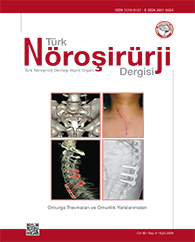Türk Nöroşirürji Dergisi
2020 , Vol 30 , Num 3
Atlas (C1) Fractures
1Sağlık Bilimleri Bakırköy Sadi Konuk Eğitim ve Araştırma Hastanesi, Nöroşirürji Kliniği, İstanbul, Türkiye
Atlas fractures mostly occur after motor vehicle accidents and falls. Computed tomography is always required to evaluate and
classify atlas fractures in detail. There is no single accepted classification system for atlas fractures. The most commonly used
classifications are the Jefferson, Landells-Van Peteghem, and Gehweiler classifications. Craniocervical junction injuries can be
categorized as isolated ligament, bone, or combined ligament and bone injury. Overall, bone injuries have higher rates of healing
by immobilization. In contrast, healing rates are low with only immobilization in ligamentous injuries. This situation forms the basis
for the management of isolated atlas fractures. In order to assess the stability of isolated atlas fractures, it is necessary to assess
the integrity of the transverse atlantal ligament (TAL) by magnetic resonance imaging and classify lesions of the transverse atlantal
ligament Most atlas fractures are stable and conservatively treated by immobilization with orthosis. Atlas fractures with transverse
atlantal ligament ınjury and an incongruence of the atlantooccipital and the atlanto-axial joints should be considered unstable and
treated surgically.
Anahtar Kelimeler :
Atlas, C1, Atlas fracture, C1 fracture, Cervical trauma

